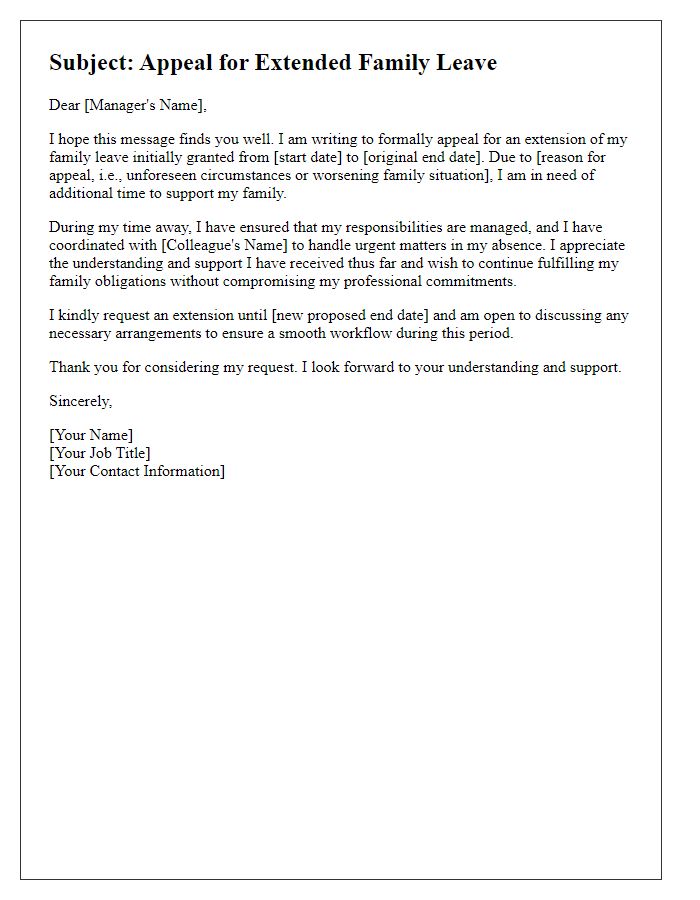Are you navigating the complexities of family leave and wondering how to secure an extension? Crafting a well-structured letter can make all the difference in ensuring your request is approved. In this article, we'll guide you through the key elements to include in your letter, from expressing your situation to outlining your need for additional time off. So, let's dive in and explore how to effectively communicate your request!

Employee's personal information and request details
An employee seeking a family leave extension must provide personal information, including the full name, employee ID, job title, and department. The request details should specify the original leave dates, intended new leave dates, and the reason for the extension, such as caring for a newborn or a family member with a serious health condition. Additional relevant medical documentation or a doctor's note may be required to support the request. This submission ensures compliance with company policies and federal regulations under the Family and Medical Leave Act (FMLA).
Reason for extension and supporting documents
A family leave extension request may be necessitated by various circumstances, such as the prolonged medical treatment for a family member, including hospitalization or rehabilitation after surgery. To ensure a smooth approval process, key supporting documents must be provided. Relevant documentation could include medical certificates from healthcare professionals or hospitals, detailing the condition of the family member and the recommended duration of care. Additionally, discharge summaries, if applicable, are crucial to demonstrate ongoing health concerns. Any previous approved leave documents, along with a clear timeline indicating the initial leave period and requested extension dates, will further substantiate the request. This information will help human resources or management make informed decisions based on current family obligations and health needs.
Impact on workflow and coverage plan
Family leave extensions can significantly impact workplace workflow and employee coverage plans. Extended absences (typically beyond the initial 12 weeks granted under FMLA regulations) may lead to increased workload for remaining team members, potentially affecting deadlines and service delivery. In departments with critical operations, such as healthcare or customer service, gaps in personnel can disrupt essential functions. To address coverage, organizations might implement temporary staffing solutions, redistribute responsibilities among existing employees, or cross-train staff members in key areas. Effective communication strategies, including regular updates and contingency planning, are crucial to maintaining workflow continuity and supporting the adjustment of teams to temporary changes in structure. Implementing these measures ensures productivity remains steady while respecting the needs of employees taking family leave.
Communication and return date expectations
Family leave extensions often require clear communication regarding the duration and expected return date. Employees must provide specific details on the leave situation, such as the nature of the family matter, anticipated duration, and the requested date for returning to work. The submission of necessary documentation, like medical certificates from healthcare providers, is crucial for approval processes. Organizations typically have policies in place for leave requests, stipulated in employee handbooks, which outline the process. Understanding these guidelines ensures that the leave request is processed smoothly, meeting both employee needs and organizational requirements.
HR policies and compliance information
Family leave extension requests require adherence to specific HR policies and compliance regulations established by the Family and Medical Leave Act (FMLA). Employees may need to provide documentary evidence, including medical certificates or care plans, to validate the need for extended leave. Approval typically hinges on the length of the leave already taken, the number of available leave days remaining, and the employer's workforce capacity. HR departments may also assess the impact on business operations and the employee's role within the organization, ensuring that any extensions are aligned with company policy. Compliance with federal and state leave regulations is crucial when processing these requests, ultimately ensuring both employee rights and organizational integrity are maintained.













Comments